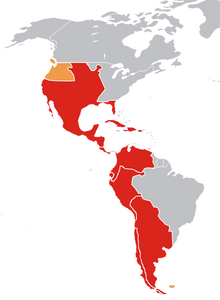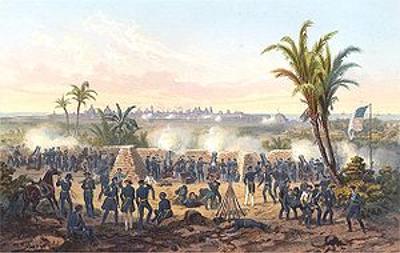|
Mexican War of Independence
(1810–1821)
|
|

The expansion of Spanish colonization of the Americas during the 18th century.
| |
The Mexican War of Independence (1810–1821) was an armed conflict between the people of Mexico and the Spanish colonial authorities which started on 16 September 1810. The Mexican War of Independence movement was led by Mexican-born Spaniards, Mestizos and Amerindians who sought independence from Spain. It started as an idealistic peasants' rebellion against their colonial masters, but finally ended as an unlikely alliance between liberals and conservatives.
It can be said that the struggle for Mexican independence dates back to the decades after the Spanish conquest of the Aztec Empire, when Martín Cortés, son of Hernán Cortés and La Malinche, led a revolt against the Spanish colonial government in order to eliminate the issues of oppression and privileges for the conquistadors.
After the abortive Conspiracy of the Machetes in 1799, the War of Independence led by the Mexican-born Spaniards became a reality. The movement for independence was far from gaining unanimous support among Mexicans, who became divided between independentists, autonomists and royalists.
Beginning of the War
|
Miguel Hidalgo y Costilla was a member of a group of educated Criollos in Querétaro who met in tertulias (salons) and who in 1810 arrived at the conclusion that a revolt against the colonial government was needed because of the events of the Peninsular War. The conspirators were betrayed by a member of the group and Hidalgo turned to his parishioners in the town of Dolores. During the night of 15 September he declared war against the government in what was known as the Grito de Dolores. On the dawn of 16 September, the revolutionary army decided to strike for independence and marched on to Guanajuato, a major colonial mining centre governed by Spaniards and criollos. There the leading citizens barricaded themselves in the granary. The rebel army captured the granary on 28 September, and most of the Spaniards and Criollos were massacred or exiled.
On October 30th, Miguel Hidalgo's army encountered Spanish resistance at the Battle of Monte de las Cruces, fought them and achieved victory. However, the rebel army failed to defeat the large and heavily armed Spanish army in Mexico City. Rebel survivors of the battle sought refuge in nearby provinces and villages. The insurgent forces planned a defensive strategy at a bridge on the Calderón River, pursued by the Spanish army.
In January 1811, Spanish forces fought the Battle of the Bridge of Calderón and defeated the insurgent army, forcing the rebels to flee towards the United States-Mexican border, where they hoped to escape. However they were intercepted by the Spanish army. Hidalgo and his remaining soldiers were captured in the state of Coahuila at the Wells of Baján (Norias de Baján). He faced court trial of the Inquisition on 30 July 1811. His body was mutilated, and his head was displayed in Guanajuato as a warning to Mexican rebels.
Independence
|
From 1815 to 1821, most of the fighting by those seeking independence from Spain was done by isolated guerrilla bands. Out of these bands rose two men, Guadalupe Victoria (born José Miguel Fernández y Félix) in Puebla and Vicente Guerrero in Oaxaca, both of whom were able to command allegiance and respect from their followers. The Spanish viceroy, however, felt the situation was under control and issued a general pardon to every rebel who would lay down his arms.
After ten years of civil war and the death of two of its founders, by early 1820 the independence movement was stalemated and close to collapse. The rebels faced stiff Spanish military resistance and the apathy of many of the most influential criollos. The violent excesses and populist zeal of Hidalgo's and Morelos's irregular armies had reinforced many criollos' fears of race and class warfare, ensuring their grudging acquiescence to conservative Spanish rule until a less bloody path to independence could be found. It was at this juncture that the machinations of a conservative military caudillo coinciding with a successful liberal rebellion in Spain, made possible a radical realignment of the proindependence forces.
In what was supposed to be the final government campaign against the insurgents, in December 1820, Viceroy Juan Ruiz de Apodaca sent a force led by a royalist criollo officer, Colonel Agustín de Iturbide, to defeat Guerrero's army in Oaxaca. Iturbide, a native of Valladolid, had gained renown for the zeal with which he persecuted Hidalgo's and Morelos's rebels during the early independence struggle. A favorite of the Mexican church hierarchy, Iturbide was the personification of conservative criollo values, devoutly religious, and committed to the defense of property rights and social privileges; he was also disgruntled at his lack of promotion and wealth.
Iturbide's assignment to the Oaxaca expedition coincided with a successful military coup in Spain against the monarchy of Ferdinand VII. The coup leaders, who had been assembled as an expeditionary force to suppress the American independence movements, compelled a reluctant Ferdinand to reinstate the liberal Spanish Constitution of 1812. When news of the liberal charter reached Mexico, Iturbide saw in it both a threat to the status quo and an opportunity for the criollos to gain control of Mexico. Ironically, independence was finally achieved when conservative forces in the colonies chose to rise up against a temporarily liberal regime in the mother country. After an initial clash with Guerrero's forces, Iturbide switched allegiances and invited the rebel leader to meet and discuss principles of a renewed independence struggle.
While stationed in the town of Iguala, Iturbide proclaimed three principles, or "guarantees," for Mexican independence from Spain; Mexico would be an independent monarchy governed by a transplanted King Ferdinand, another Bourbon prince, or some other conservative European prince, criollos and peninsulares would henceforth enjoy equal rights and privileges, and the Roman Catholic Church would retain its privileges and religious monopoly. After convincing his troops to accept the principles, which were promulgated on February 24, 1821, as the Plan of Iguala, Iturbide persuaded Guerrero to join his forces in support of the new conservative manifestation of the independence movement. A new army, the Army of the Three Guarantees, was then placed under Iturbide's command to enforce the Plan of Iguala. The plan was so broadly based that it pleased both patriots and loyalists. The goal of independence and the protection of Roman Catholicism brought together all factions.
Iturbide's army was joined by rebel forces from all over Mexico. When the rebels' victory became certain, the viceroy resigned. On August 24, 1821, representatives of the Spanish crown and Iturbide signed the Treaty of Córdoba, which recognized Mexican independence under the terms of the Plan of Iguala. On September 27 the Army of the Three Guarantees entered Mexico City and the following day Iturbide proclaimed the independence of the Mexican Empire, as New Spain was to be henceforth called. The Treaty of Córdoba was not ratified by the Spanish Cortes. Iturbide, a former royalist who had become the paladin for Mexican independence, included a special clause in the treaty that left open the possibility for a criollo monarch to be appointed by a Mexican congress if no suitable member of the European royalty would accept the Mexican crown.
On the night of the May 18, 1822, a mass demonstration led by the Regiment of Celaya, which Iturbide had commanded during the war, marched through the streets and demanded that their commander-in-chief accept the throne. The following day, the congress declared Iturbide emperor of Mexico.
|
 |
| A painting of the Battle of Veracruz by Carl Nebel |
|
|
 |
| Other Militaria |
|
|
To all Visitors
This site has been developed not just to sell Antiques and Collectibles (of course it does some of that) rather it is to provide information about Antiques, Collectibles, artwork, art pottery, furniture types, furniture styles, jewelry, and militaria from the Revolutionary War to the Vietnam War. This site is all about information and history that is not readily available elsewhere on the Internet. We think West St Paul Antiques is one of the best Antique Malls in the State of Minnesota and we have been working hard to create that excellence for the last 12 years. We have expertise on Antiques & Collectibles and as we read and study about history and antiques we also strive to be historians. We will share that expertise with you and all the visitors to our site. Stop by and visit our Antique Mall in West St Paul, Minnesota. Or, you are all welcome to visit us on the web.
This is a new website for us at West St Paul Antiques. We hope you enjoy the site. Please feel free to email me directly at floydruggles@weststpaulantiques.com if you have any questions or feedback about this site. Please sign our guest book and check out our Poetry Coffee Cup Cafe, or the Out and About Gallery. The Reference Library an all 5 Museums are open to you 24/7 on this website. Stop by one of the 1st Recon Battalion pages where you can read about my experiences in Vietnam. Oh, by the way, also check out all our Antiques, Collectibles, artwork, art pottery, clocks, mall specials, furniture types and styles, jewelry and militaria items for sale on this site and in our Antique Mall. Check it out by going to Antique Mall Tour. This site will be totally commercial free with no fees to pay. I'll be working on this site over time so bear with me. It should be finished by the end of 2010 with over 500 pages at that time and 900 pages by the end of next year.
Click here to go to our web Site Map and Categories.
|
Click a NEW link
To browse our Home page, Look over our Museums, 1st Reconnaissance Battalion pages, Recon Photo Gallery,
Out and About Gallery, Poetry Coffee Cup Cafe, About Us, Christmas Index, Antique Mall Tour,
Antiques & Collectibles, Furniture, Jewelry, Art Pottery, Artwork, Militaria,Contact Us, Hours and Directions,
Dealers pages, Consignment, Ebay Store, Translate this Website, Our Blogs, Books, Bottles & Jars, China, Crystal & Glass,
No Man Left Behind, Who Was Really the First President of the United States, Halloween pages, Primitives, Antique Photos,
The Day Eagle Cried, Financial Tip of the Year & Remembering The 50's & 60's Music Index.
or
Go to the top of each page of our website for the menu bar of categories. You will see a drop down menu appear for each category. Click a link to browse or click our
Site Map and Categories to find your link.
|
|
 |
| Me with your feedback on how I can Improve this website. |
|
| |
|